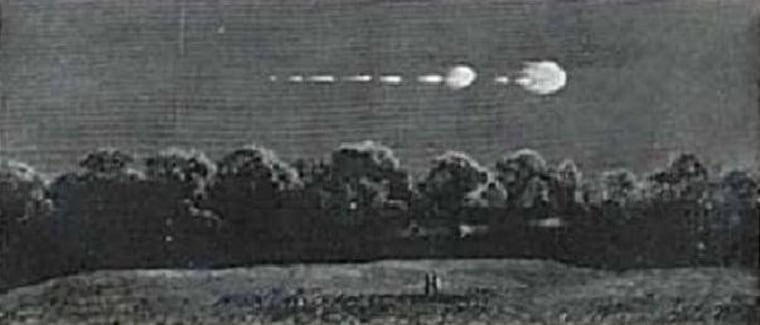Academic sleuths have used fine art and old newspapers to figure out exactly which meteor Walt Whitman was talking about in his poem "Year of Meteors (1859-60)." It's the latest example of a historical exercise known as "forensic astronomy." The "strange huge meteor procession" that Whitman saw occurred on July 20, 1860, researchers from Texas State University at San Marcos report in the July 2010 edition of Sky & Telescope magazine. The event inspired not only Whitman, but the famed landscape painter Frederic Church as well - and it was Church's painting that helped solve the mystery. "This is the 150th anniversary of the event that inspired both Whitman and Church," Texas State physics professor Donald Olson said in a university news release. "It was an Earth-grazing meteor procession." Whitman's poem, which appears in his masterwork "Leaves of Grass," was the mid-19th-century equivalent of a YouTube mash-up: It combined references to current events (such as abolitionist John Brown's 1859 execution and the 1860 presidential campaign, which he called the "19th Presidentiad") with astronomical observations. One such skywatching highlight was the "Great Comet of 1860," which Whitman refers to as a "comet that came unannounced out of the north." That well-known dazzler became visible in June of that year and sparked a worldwide sensation. But Whitman also mentioned the strange meteor procession, "dazzling and clear, shooting over our heads." What was that all about? That was a perfect puzzler for Olson and his colleagues, who have solved other historical mysteries ranging from the running of the first marathon to the vantage point used by photographer Ansel Adams for his famous "Autumn Moon" picture. In the decades since Whitman wrote his poem, readers have speculated that he was perhaps referring to an 1833 Leonid meteor storm, or the 1858 Leonids, or a famous fireball fall in 1859. None of those was a close match for the kind of procession that the poet described, however. Olson was sure that Whitman was instead referring to an Earth-grazing meteor, which streaks into the upper atmosphere and back out without falling to the ground. Earth-grazers can create a procession of fireworks when they break up into pieces during the flight. "Meteor processions are so rare most people have never heard of them," Olson said. "There was one in 1783 and a Canadian fireball procession in 1913. Those were all the meteor processions we knew of." Until, that is, Olson followed up on Church's painting. He had seen a picture of the work, titled "The Meteor of 1860," on the back cover of an exhibition catalog. The scene paralleled Whitman's description of the strange procession, and the catalog gave July 20 as the date of Church's observation. When Olson and his colleagues did further research, they found out that Church and his wife were honeymooning that summer beneath the same skies that Whitman saw. "We went to a small research library and found old diaries of Theodore Cole, a friend of Church's, from July of 1860," said Texas State student Ava Pope, one of Olson's collaborators. "They tell us Church was, in fact, in Catskill, New York, so he wasn't off in some far distant land." Further confirmation came when the team went through newspapers from that summer, and found numerous reports about a large Earth-grazing meteor that broke apart on the evening of July 20, 1860, creating a train of fireballs that was visible from the Great Lakes across New York state. "From all the observations in towns up and down the Hudson River Valley, we're able to determine the meteor's appearance down to the hour and minute," Olson said. "Church observed it at 9:49 p.m. when the meteor passed overhead, and Walt Whitman would've seen it at the same time, give or take one minute." For Whitman, the short-lived, dazzling meteor encapsulated the age: a year of Southern discontent and Northern foreboding that was "transient and strange." "Its appearance, right before the Civil War, at a time of growth and anxiety for America, made it a metaphor and a portent in the public imagination," said Marilynn Olson, a Texas State professor of English literature. She and physicist Russell Doescher rounded out the forensic-astronomy team. Are we in the midst of another "transient and strange" year, "all mottled with evil and good"? If so, prime meteor season is coming up. You can look forward to the Lyrids (peaking June 14-16), the Delta Aquarids and the Capricornids (July 28-30) and one of the best-known meteor showers of the year, the Perseids (peaking Aug. 12-13). Watch out for those Earth-grazers! Further frontiers in forensic astronomy:
- Science of 'The Scream'
- Van Gogh "Moonrise" mystery solved
- Astronomers revise date of Marathon battle
- New light on Ansel Adams' moon masterpiece
- NPR: Scientist looks to stars for answer on Caesar
Join the Cosmic Log corps by signing up as my Facebook friend or hooking up on Twitter. And if you really want to be friendly, ask me about "The Case for Pluto."
